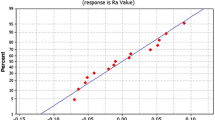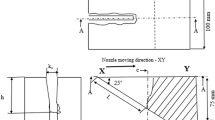Abstract
Prediction of surface roughness has always been a challenging task in the abrasive waterjet machining (AWJM) of metal matrix composites (MMCs), since it involves quite a number of process and material variables. The present study explores the prediction of surface roughness (Ra) through development of models, namely regression and semi-empirical models for AWJM of unreinforced Al 6063 alloy, Al 6063 reinforced with 5%, 10%, and 15% boron carbide (B4C) particles. Accordingly, AWJM trials were performed using Box-Behnken experimental design by kee** the process variables viz. mesh size (ms), mass flow rate (ma), water pressure (p), and traverse speed (u) each at three levels. Response surface methodology (RSM) was applied to formulate a regression model using the data generated from experiments. The results analyzed through analysis of variance (ANOVA) revealed that ms, water pressure, and traverse speed render a significant contribution in the generation of Ra. The experimental investigations showed that the combination of process parameters such as ms of # 120, mass flow rate of 340 g/min, water pressure of 275 MPa, and traverse speed of 60 mm/min have resulted in lower Ra. By utilizing both the experimental data and materials properties data, a semi-empirical model was developed through dimensional analysis by applying Buckingham’s π-theorem. Predictions of the developed models were in good correlation with the data obtained through experiments under corresponding conditions. The study undertaken here proved that the semi-empirical models could efficiently predict the Ra in AWJM of MMCs.
















Similar content being viewed by others
Data availability
All data generated or analyzed during this study are included in this published article.
The submitted work is original, complete and has not been submitted/published elsewhere in any form or language.
Abbreviations
- \({d}_{n}\) :
-
Diameter of nozzle (mm)
- \({d}_{0}\) :
-
Diameter of orifice (mm)
- \({d}_{p}\) :
-
Diameter of abrasive particles (mm)
- \({E}_{c}\) :
-
Modulus of elasticity—composite (MPa)
- \({E}_{m}\) :
-
Modulus of elasticity—matrix (MPa)
- \({E}_{p}\) :
-
Modulus of elasticity—particles (MPa)
- H c :
-
Hardness of the workpiece (MPa)
- \({k}_{t}\) :
-
Momentum transfer coefficient
- \({k}_{d}\) :
-
Coefficient of discharge
- lm :
-
Mixing tube length (mm)
- L:
-
Slant length (mm)
- \({m}_{a}\) :
-
Mass flow rate of abrasive (g/min)
- \({m}_{s}\) :
-
Mass flow rate of slurry (g/min)
- \({m}_{w}\) :
-
Mass flow rate of water (g/min)
- ms :
-
Mesh size of abrasives (#)
- p :
-
Water pressure (MPa)
- R a :
-
Surface roughness (µm)
- u :
-
Traverse speed (mm/min)
- \({S}_{d}\) :
-
Standoff distance (mm)
- s:
-
Particle ratio
- \({v}_{a}\) :
-
Velocity of abrasive particles (mm/min)
- \({v}_{w}\) :
-
Velocity of waterjet (mm/min)
- \({V}_{p}\) :
-
Volume content of reinforced particles (mm3)
- \({V}_{m}\) :
-
Volume content of matrix (mm3
- \({\sigma }_{c}\) :
-
Compressive strength (MPa)
- \({\sigma }_{f}\) :
-
Dynamic flow stress (MPa)
- \({\rho }_{w}\) :
-
Density of water (g/mm3)
- \({\rho }_{p}\) :
-
Density of the abrasive particles (g/mm3)
- θ:
-
Jet im**ement angle ( ͦ)
- \({x}_{1}\),\({x}_{2}\),\({x}_{3}\),\({x}_{4}\), \({x}_{5}\) \({x}_{6}, { x}_{7 }, { x}_{8}\) \(\mathrm{and}\) \({x}_{9}\) :
-
Exponential constants
References
Chawla KK (2019) Composite materials: science and engineering. Switzerland: Springer Science & Business Media. https://doi.org/10.1007/978-0-387-74365-3B
Mohankumar V, Kanthababu M, Raveendran R (2015) Review on machining aspects in metal matrix and ceramic matrix composites using abrasive waterjet. Appl Mech Mater 766-767:643-648. https://doi.org/10.4028/www.scientific.net/AMM.766-767.643
Muller F, Monaghan J (2001) Non-conventional machining of particle reinforced metal matrix composite. J Mater Process Technol 118:278–285. https://doi.org/10.1016/S0924-0136(01)00941-4
Momber AW, Kovacevic R (2012) Principles of abrasive water jet machining. London: Springer-Verlag
Kanthababu M, Chetty OVK (2002) Abrasive water jet machining of black granite with garnet abrasives. J Inst Eng (India) Prod Eng Div 83(1):7–14
Kanthababu M, Chetty OVK (2003) Studies on abrasive waterjet machining of black granite through design of experiments. Exp Tech 27(5):49–54. https://doi.org/10.1111/j.1747-1567.2003.tb00131.x
Wang S, Yang F, Dong Hu, Tang C, Lin P (2021) Modelling and analysis of abrasive water jet cutting front profile. Int J Adv Manuf Technol 112(1–4):1–7. https://doi.org/10.1007/s00170-021-07014-5
Arrazola PJ, Ozel T, Umbrello D, Davies M, Jawahir IS (2013) Recent advances in modelling of metal machining processes. CIRP Ann Manuf Technol 62:695–718. https://doi.org/10.1016/j.cirp.2013.05.006
Patil NG, Brahmankar PK (2010) Determination of material removal rate in wire electro-discharge machining of metal matrix composites using dimensional analysis. Int J Adv Manuf Technol 51(5–8):599–610. https://doi.org/10.1007/s00170-009-2291-5
Kovacevic R (1991) Surface texture in abrasive waterjet cutting. J Manuf Syst 10(1):32–40
Schwartzentruber J, Spelt JK, Papini M (2017) Prediction of surface roughness in abrasive waterjet trimming of fiber reinforced polymer composites. Int J Mach Tools Manuf 122:1–17. https://doi.org/10.1016/j.ijmachtools.2017.05.007
Bañon F, Sambruno A, Batista M, Simonet B, Salguero J (2020) Study of the surface quality of carbon fiber–reinforced thermoplastic matrix composite (CFRTP) machined by abrasive water jet (AWJM). Int J Adv Manuf Technol 107:3299–3313. https://doi.org/10.1007/s00170-020-05215-y
Jankovic P, Igic T, Nikodijevic D (2013) Process parameters effect on material removal mechanism and cut quality of abrasive water jet machining. Theor Appl Mech Lett 40:277–291. https://doi.org/10.2298/TAM1302277J
Arola D, Ramulu M (1996) A Study of kerf characteristics in abrasive waterjet machining of graphite/epoxy composite. J Eng Mater Technol 118(2):256–265. https://doi.org/10.1115/1.2804897
Azmir MA, Ahsan AK (2009) A study of abrasive water jet machining process on glass/epoxy composite laminate. Journal of Material Process Technology 209:6168–6173. https://doi.org/10.1016/j.jmatprotec.2009.08.011
Unde PD, Gayakwad MD, Patil NG, Pawade RS, Thakur DG, Brahmankar PK (2015) Experimental investigations into abrasive waterjet machining of carbon fiber reinforced plastic. J Compos 1-9. https://doi.org/10.1155/2015/971596
Mohankumar V, Kanthababu M (2020) Semi-empirical model for depth of cut in abrasive waterjet machining of metal matrix composites. J Braz Soc Mech Sci Eng 42(10):1–17. https://doi.org/10.1007/s40430-020-02581-2
Shanmugam DK, Wang J, Liu H (2008) Minimization of kerf tapers in abrasive waterjet machining of alumina ceramics using a compensation technique. Int J Mach Tools Manuf 48(14):1527–1534. https://doi.org/10.1016/j.ijmachtools.2008.07.001
Pahuja R, Ramulu M (2019) Abrasive water jet machining of titanium Ti6Al4V / CFRP stacks-a semi-analytical modeling approach in the prediction of kerf geometry. J Manuf Process 39:327–337. https://doi.org/10.1016/j.jmapro.2019.01.041
Dinesh S, Rajkamal S, Shukla (2020) Integration of quality characteristics models as a software‑based graphical interface for machining of AA6351 aluminum alloy using abrasive water jet process. J Braz Soc Mech Sci Eng 42:330-3. https://doi.org/10.1007/s40430-020-02410-6
Lloyd D (1994) Particle reinforced aluminium and magnesium matrix composites. Int Mater Rev 39(1):1–23
Hashish M (1989) A model for abrasive waterjet (AWJ) machining. J Eng Technol 111:155–161
Jegaraj JR, Rameshbabu N (2005) A strategy for efficient and quality cutting of materials with abrasive waterjets considering the variation in orifice and focusing nozzle diameter. Int J Mach Tools Manufact 45:1443–1450. https://doi.org/10.1016/j.ijmachtools.2005.01.020
Srinivas S, Ramesh Babu N (2012) Penetration ability of abrasive waterjets in cutting of aluminium-silicon carbide particulate metal matrix composites. Mech Sci Technol 16:337–354. https://doi.org/10.1080/10910344.2012.698935
Montgomery DC (2017) Design and analysis of experiments. New Jersey: Wiley
Bansal RK (2010) A textbook of fluid mechanics and hydraulic machines. India: Laxmi Publications
Chakravarthy PS, Rameshbabu N (1997) A semi-empirical model for cutting granite with abrasive waterjets, In: Proceedings of the 17th All India Manufacturing Technology Design and Research Conference pp 259 - 262
Chen T, Wang C (2013) Investigation into roughness of surface polished by abrasive waterjet with Taguchi method and dimensional analysis. Mater Sci Forum 723:188-195. https://doi.org/10.4028/www.scientific.net/MSF.723.188
Xu S, Wang J (2006) A study of abrasive waterjet cutting of alumina ceramics with controlled nozzle oscillation. Int J Adv Manuf Technol 27(7–8):693. https://doi.org/10.1007/s00170-004-2256-7
Hashish M (2003) Inside AWJ nozzles. In Proceedings of 12th WJTA American Waterjet Conference, pp 17–19.
Pramanik A (2014) Development in the non-traditional machining of particle reinforced metal matrix composites. Int J Mach Tools Manuf 86:44–61. https://doi.org/10.1016/j.ijmachtools.2014.07.003
Sasikumar KSK, Arulshri KP, Ponappa K, Uthayakumar M (2018) A study on kerf characteristics of hybrid aluminium 7075 metal matrix composites machined using abrasive water jet machining technology. Proc Inst Mech Eng B J Eng Manufact 232:690–704. https://doi.org/10.1177/0954405416654085
Hascalik A, Çaydaş U, Gürün H (2007) Effect of traverse speed on abrasive waterjet machining of Ti–6Al–4V alloy. Mater Des 28(6):1953–1957. https://doi.org/10.1016/j.matdes.2006.04.020
Kok M, Kanca E, Eyercioglu O (2011) Prediction of surface roughness in abrasive waterjet machining of particle reinforced MMCs using genetic expression programming. Int J Adv Manuf Technol 55:955–968. https://doi.org/10.1007/s00170-010-3122-4
Zhao W, Guo C (2004) Topography and microstructure of the cutting surface machined with abrasive waterjet. Int J Adv Manufact Technol 73:941–947. https://doi.org/10.1007/s00170-014-5869-5
Mayuet APF, Rodríguez-Parada L, Gómez-Parra Á, Batista PM (2020) Characterization and defect analysis of machined regions in Al-SiC metal matrix composites using an abrasive water jet machining process. Appl Sci 10(4):1512. https://doi.org/10.3390/app10041512
Bouda F, Carpenter C, Folkesa J, Shipway PH (2010) Abrasive waterjet cutting of a titanium alloy: the influence of abrasive morphology and mechanical properties on workpiece grit embedment and cut quality. J Mater Process Technol 210:2197–2205. https://doi.org/10.1016/j.jmatprotec.2010.08.006
Hamatani G, Ramulu M (1990) Machinability of high temperature composites by abrasive water jet. J Eng Mater Technol 112(4):381–386. https://doi.org/10.1115/1.2903346
Hawkins DM (2004) The problem of overfitting. J Chem Inf Comput Sci 44(1):1–12. https://doi.org/10.1021/ci0342472
Funding
This work is financially supported under Special Assistance Programme (SAP) by the University Grants Commission (UGC), New Delhi, India (UGC Ref. No. F.3–41/2012 (SAPII)) to the Department of Manufacturing Engineering, Anna University, Chennai.
Author information
Authors and Affiliations
Contributions
Mohankumar Veeraraghavan – carried out experimental work, surface roughness measurement, calculated the material properties, developed semi-empirical as well as regression models and prepared the manuscript. Kanthababu Mani – obtained a grant for the machining setup and installed the machine in the department for research work and meticulously planned the experimentation of this work and carried out statistical analysis (ANOVA) from the experimental data and compared them with semi-empirical and regression models. He also modified the structure of the article and carried out in-depth analysis of the data. Velayudham Arumugam – studied and analyzed the behavior of AWJM of MMC with respect to the machining aspects and material removal mechanism in terms of surface characterization using the images from SEM and experimental data. Overall, all the authors have contributed equally to the outcome of this work.
Corresponding author
Ethics declarations
Human and Animal Rights
Human participants/animals were not involved in this part of work that requires any ethical approval.
Consent to participate
Not applicable.
Consent to publish
The authors willingly provide their consent to publish this manuscript in the International Journal of Advanced Manufacturing Technology.
Conflict of interest
The authors declare no competing interests.
Additional information
Publisher's Note
Springer Nature remains neutral with regard to jurisdictional claims in published maps and institutional affiliations.
Rights and permissions
About this article
Cite this article
Veeraraghavan, M., Mani, K. & Arumugam, V. Prediction of surface roughness using semi-empirical and regression models in machining of metal matrix composites using abrasive waterjet. Int J Adv Manuf Technol 119, 1623–1645 (2022). https://doi.org/10.1007/s00170-021-08150-8
Received:
Accepted:
Published:
Issue Date:
DOI: https://doi.org/10.1007/s00170-021-08150-8




